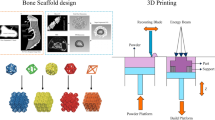Abstract
Several progresses have been introduced in the field of bone regenerative medicine. A new term tissue engineering (TE) was created. In TE, a highly porous artificial extracellular matrix or scaffold is required to accommodate cells and guide their growth in three dimensions. The design of scaffolds with desirable internal and external structure represents a challenge for TE. In this paper, we introduce a new method known as automated scaffold design (ASD) for designing a 3D scaffold with a minimum mismatches for its geometrical parameters. The method makes use of k-means clustering algorithm to separate the different tissues and hence decodes the defected bone portions. The segmented portions of different slices are registered to construct the 3D volume for the data. It also uses an isosurface rendering technique for 3D visualization of the scaffold and bones. It provides the ability to visualize the transplanted as well as the normal bone portions. The proposed system proves good performance in both the segmentation results and visualizations aspects.








Similar content being viewed by others
References
Porter JR, Ruckh TT, Popat KC (2009) Bone tissue engineering: a review in bone biomimetic and drug delivery strategies. Biotechnol Prog (AIChE) 25:1539–1560
B. Starly (2006) Biomimetic design and fabrication of tissue engineered scaffolds using computer aided tissue engineering. A thesis submitted to Drexel University, USA
Stevens MM (2008) Biomaterials for bone tissue engineering. Mater Today 11:18–25. doi:10.1016/S1369-7021(08)70086-5
Silber JS et al (2003) Donor site morbidity after anterior iliac crest bone harvest for single-level anterior cervical discectomy and fusion. Spine 28:134–139
Bose S, Roy M, Bandyopadhyay A (2012) Recent advances in bone tissue engineering scaffolds. Trends Inbiotechnol 30(10):546–554
Kneser U, Schaefer DJ, Munder B, Klemt C, Andree C, Stark GB (2002) Tissue engineering of bone. Minim Invasive Ther Allied Technol 11(3):107–116
Langer R, Vacanti JP (1993) Tissue engineering. Science 260(5110):920–926
Ikada Y (2006) Challenges in tissue engineering. J R Soc Interface 3:589–601
Bonadio J, Smiley E, Patil P, Goldstein S (1999) Localized, direct plasmid gene delivery in vivo: prolonged therapy results in reproducible tissue regeneration. Nat Med 5(7):753–759
Hutmacher DW (2000) Scaffolds in tissue engineering bone and cartilage. Biomaterials 21(24):2529–2543
Hutmacher DW (2001) Scaffold design and fabrication technologies for engineering tissues state of the art and future perspectives. J Biomater Sci Polym Ed 12(1):107–124
De Boer J, Van Blitterswijk C, Thomsen P, Hubbell J, de Ranieri Cancedda JD, Bruijn AL, Sohier J, Williams DF (2008) Tissue engineering, 1st edn. Elsevier Academic Press, London
Salgado AJ, Coutinho OP, Reis RL (2004) Bone tissue engineering: state of the art and future trends. Macromol Biosci 4:743–765
Hollister SJ (2005) Porous scaffold design for tissue engineering. Nat Mater 4(7):518–524
Starlya B, Laub W, Bradburyb T, Sun W (2005) Internal architecture design and freeform fabrication. Comput Aided Des 38:115–124
Ramin E, Harris RA (2009) Automated design of tissue engineering scaffolds by advanced cad. Proc Inst Mech Eng 223(3):289–301
Gonzalez RC, Woods RE (2002) Digital image processing. Prentice-Hall, Englewood Cliffs
Singh KK, Singh A (2010) A study of image segmentation algorithms for different types of images. Int J Comput Sci Issues (IJCSI) 7(5):414–417
Jipkate MBR, Gohokar VV (2012) A comparative analysis of fuzzy c-means clustering and k means clustering algorithms. Int J Comput Eng (IJCER) 2(3):737–739
Ghosh S, Dubey SK (2013) Comparative analysis of k-means and fuzzy c-means algorithms. Int J Adv Comput Sci Appl (IJACSA) 4:35–39
Umbaugh SE (1998) computer vision and image processing. Prentice Hall, Upper Saddle River
Antoine Maintz JB, Viergever MA (1998) A survey of medical image registration. Med Image Anal 2:1–36
Deshmukh MP, Bhosle U (2011) A survey of image registration. Inter J Image Process (IJIP) 5:245–269
Kumar R, Rattan M (2012) Analysis of various quality metrics for medical image processing. Inter J Adv Res Comput Sci Softw Eng(IJARCSSE) 2(11):137–144
Torres PMB, Gonçalves PJS, Martins JMM (2012) 3D Reconstruction and visualization of femur bone structures. Rom Rev Precis Mech Opt Mechatron 41:51–56
Lorensen WE, Cline HE (1987) Marching cubes: a high resolution 3d surface construction algorithm. ACM SIGGRAPH Comput Graph 21(4):163–169
Kalyankar PP, Apte SS (2013) 3D Volume rendering algorithm. Int J Eng Adv Technol (IJEAT) 2(5):268–270
Wikipedia website, en.wikipedia.org/wiki/Sensitivityandspecificity
Acknowledgments
This work is supported by Department of Systems and Biomedical Engineering, Faculty of Engineering, Cairo University, Egypt.
Author information
Authors and Affiliations
Corresponding author
Rights and permissions
About this article
Cite this article
Mahmoud, S., Eldeib, A. & Samy, S. The design of 3D scaffold for tissue engineering using automated scaffold design algorithm. Australas Phys Eng Sci Med 38, 223–228 (2015). https://doi.org/10.1007/s13246-015-0339-4
Received:
Accepted:
Published:
Issue Date:
DOI: https://doi.org/10.1007/s13246-015-0339-4




